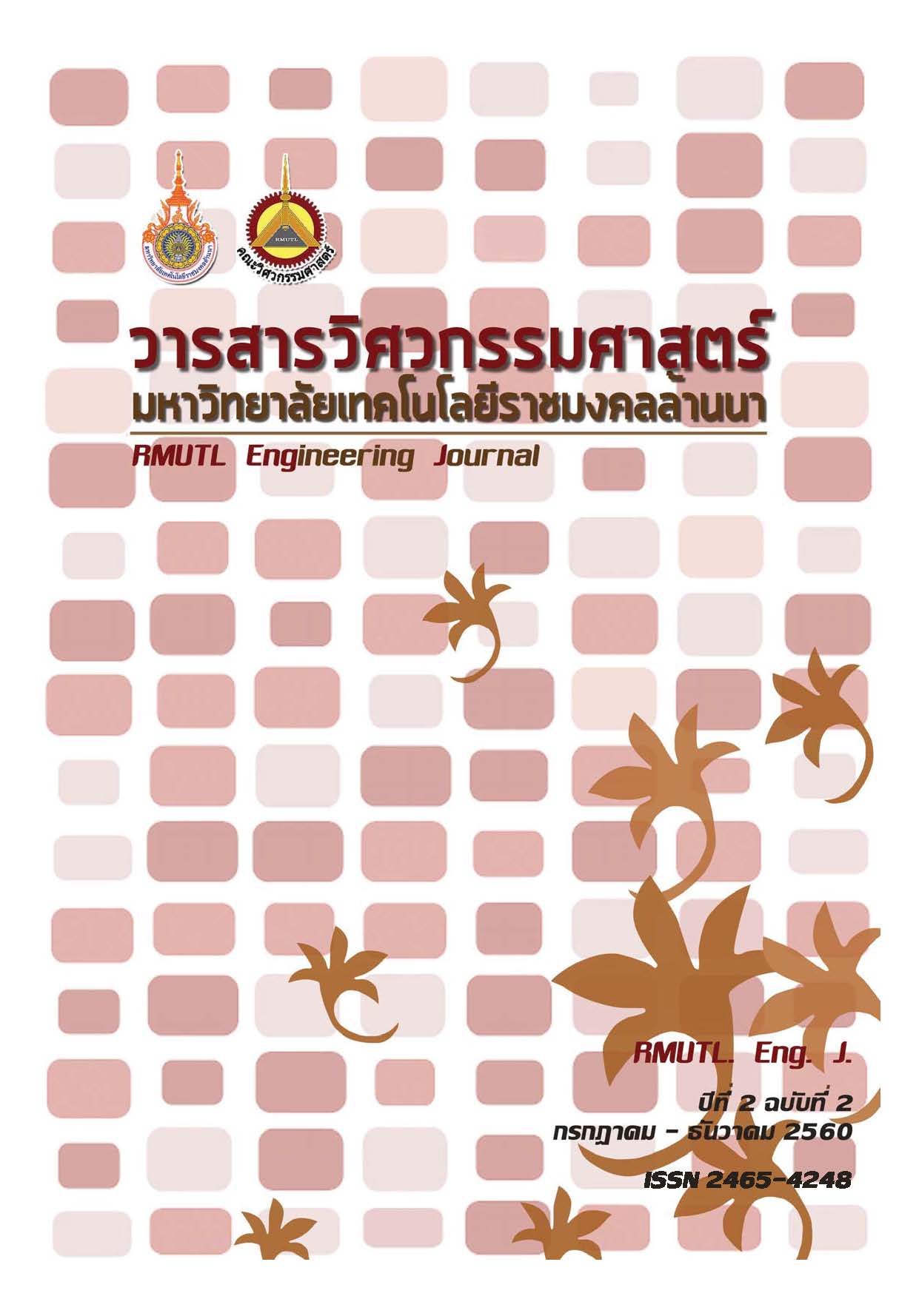A Perspective on the Gas and Liquid Electrical Discharge of Plasma for Agriculture Applications: Part I. Enhancement of Yield in Plant Lifecycle.
DOI:
https://doi.org/10.14456/rmutlengj.2017.9Keywords:
Plasma applications, atmospheric pressure plasmas, chemical plasma treatment, gas discharge plasma, underwater electrical discharge plasma, plant cultivation, agriculture, high voltage techniquesAbstract
This paper presents a literature review of recent techniques for increasing agricultural productivity of the whole plant lifecycle by using non-thermal atmospheric pressure plasma (NTAPP) technology. Also presented are all of current NTAPPs in gas and liquid that are being invented at High Voltage Engineering Laboratory, Rajamangala University of Technology Lanna, Chiang Mai, Thailand. Our NTAPPs are designed to be applicable in advanced research of agriculture works in the future. The NTAPPs’ approaches are presented, along with the preliminary results. In the past, plasma gas or liquid discharge from high voltage for agricultural applications were usually used to deactivate or kill microorganisms and pathogens in water or gas. However, recent research activities aim to increase agricultural productivity of the whole plant lifecycle by using non-thermal atmospheric pressure plasma (NTAPP) technology to fulfill the needs of industrial agriculture. Recent literature review in the past half-decade showed that NTAPP offers benefits of enhancing the nutrition characteristics of seeds and increasing seed germination rate. Furthermore, NTAPP can help increase plant growth rate and nutritional yield and subsequently agricultural produce quality. NTAPP can not only deactivate microorganisms on the surfaces or in the water but can also fix nutrients necessary for plants to grow in soil and water. After the harvest, the NTAPP has been used to maintain the freshness of the vegetables and fruits that has the benefit of reduced costs of storage and transportation.
References
2. สำนักงานสถิติแห่งชาติ (ประเทศไทย): ทิศทางการทำงานของแรงงานไทย สืบค้นจาก: https://service.nso.go.th/nso/nsopublish/citizen/news/news_lfsdirect.jsp [สืบค้นเมื่อ 13 ตุลาคม 2559].
3. UN News Centre: UN projects world population to reach 8.5 billion by 2030, driven by growth in developing countries. Available from: http//www.un.org/appsnews/story.asp?NewsID=51526#.WBWk4nRGzqA [Accessed 13th October 2016].
4. Solly, E., The influence of electricity on vegetation, Journal of the Horticultural Society (London) 1845; 81-109.
5. S.L. Miller, H.C. Urey, Organic compound synthesis on the primitive earth, Science 1959; 130 (3370): 245-251.
6. S. Edward Law, Agricultural electrostatic spray application: a review of significant research and development during the 20th century, Journal of Electrostatics 2001; 51-52: 25-42.
7. Savostin PW, Magnetic growth relations in plants. Planta 1930; 12:327.
8. Namba K, Sasao A, Shibusawa S, Effect of magnetic field on germination and plant growth. Acta Hortic. 1995; 399: 143-147.
9. Atak C, Danilov V, Yurttas B, Yaln S, Mutlu D, Rzakoulieva A, Effects of magnetic field on soybean (Glycine max L.Merrill) seeds. Com JINR. Dubna 1997; 1-13.
10. Reina FG, Pascual LA, Fundora IA, Influence of a Stationary Magnetic Field on water relations in lettuce Seeds. Part II: Experimental Results. Bioelectromagnetics 2001; 22: 596-602.
11. Amera AMS, Hozayn M, Magntic water technology, a novel tool to increase growth, yield, and chemical constiuents of lentil (Lens esculenta) under greenhouse condition. Amer.-Eurasian J. Agric. Environ. Sci 2010; 7(4):457-462
12. Pietruszewski S, Kania K, Effect of magnetic field on germination and yield of wheat. Int. Agrophys 2010; 24:297-302.
13. Hozayn M, Abd El-Monem AM, Elwia TA, Abdallah MM, Future of magnetic agriculture in arid and semi arid regions (case study). Series A. Agron 2014; 57:197-204.
14. Alexander F., Introduction to Theoretical and Applied Plasma Chemistry, Plasma Chemistry. UK: Cambridge Univ. Press; 2008, 1-11.
15. Shishoo R., Trent JM. Introduction – The potential of plasma technology in the textile industry, Plasma technologies for textiles. USA: Woodhead Publishing Limited and CRC Press LLC; 2002. p. 15-17.
16. Shalom Eliezer, What is Plasma?, The Fourth State of Matter. Second Edition. UK: IOP Publishing Ltd; 2002. p. 22-48.
17. Dechthummarong C., High Voltage Power Supply for Generating Atmospheric Pressure Plasma with Surface Glow Discharge, Thai Journal Of Physics, Series 6, 2010; 211-214.
18. อิทธิพล จักกระโทก และ ชาญชัย เดชธรรมรงค์, อิทธิพลของพลาสมาแรงดันสูงความถี่สูงที่มีผลต่อการปรับสภาพผิวของพอลิเมอร์, การประชุมวิชาการเครือข่ายวิศวกรรมไฟฟ้า มหาวิทยาลัยเทคโนโลยีราชมงคล ครั้งที่ 7, 27-29 พฤษภาคม 2558; 1-4.
19. C. Comninellis, A. Kapalka, S. Malato, S.A. Parsons, I. Poulios, D. Mantzavinos, Advanced oxidation processes for water treatment: advances and trends for R&D, J. Chem. Technol. Biotechnol. 2008; 83: 769–776.
20. M. Klavarioti, D. Mantzavinos, D. Kassinos, Removal of residual pharmaceuticals from aqueous systems by advanced oxidation processes, Environ. Int. 2009; 35: 402–417.
21. J.C. Kruithof, P.C. Kamp, B.J. Martijn, UV/H2O2 treatment: a practical solution for organic contaminant control and primary disinfection, Ozone Sci. Eng. 2007; 29: 273–280.
22. R.P. Joshi, S.M. Thagard, Streamer-like electric discharges in water: Part II. Environmental applications, Plasma Chem. Plasma Process. 2013; 33: 17–49.
23. K Takaki et al., Improvements in plant growth rate using underwater discharge, 7th Inter. Conf. on Applied Electrostatics (ICAES-2012), Journal of Physics: Conference 2013: 418, 012140; 1-7.
24. Junichiro Takahata et al., Improvement of growth rate of plants by bubble discharge in water, Japanese Journal of Applied Physics, 2015; 54: 1-6.
25. Marx, E. Deutsches Reichspatent No. 455933, (German Patent).
26. Shaobo Deng et al., Inactivation of Escherichia coli on Almonds Using Non-thermal Plasma, Food Microb. and Safety, 2007; 72(2): M62-M66.
27. Leszek Kordas et al., The Effect of Low-Temperature Plasma on Fungus Colonization of Winter Wheat Grain and Seed Quality, Pol. J. Environ. Stud., 2015; 24(1): 433-438.
28. Pradeep Puligundla et al., Effect of corona discharge plasma jet treatment on decontamination and sprouting of rapeseed (Brassica napus L.) seeds, Food Control, 2017 (Available online 18 July 2016), 71: 376-382.
29. Ruonan Ma et al., Non-thermal plasma-activated water inactivation of food-bornepathogen on fresh produce, Journal of Hazardous Materials, 2015; 300: 643–651.
30. Phumon Sookwong et al., Application of Oxygen-argon Plasma as a Potential Approach of Improving the Nutrition Value of Pre-germinated Brown Rice, Journal of Food and Nutrition Research, 2014; 2(12): 946-951.
31. Natthaporn Khamsen et al., Rice (Oryza sativa L.) Seed Sterilization and Germination Enhancement via Atmospheric Hybrid Non-thermal Discharge Plasma, ACS Applied Mat. and Int., 2016; 8 (30): 19268–19275.
32. Zhuwen Zhou et al., Introduction of a new atmospheric pressure plasma device and application on tomato seeds, Agricultural Sciences, 2011; 2: 23-27.
33. Tibor Stolarik et al., Effect of Low-Temperature Plasma on the Structure of Seeds, Growth and Metabolism of Endogenous Phytohormones in Pea (Pisum sativum L.), 2015; 35: 659–676.
34. Satoshi Kitazaki et al., Plasma induced long-term growth enhancement of Raphanus sativus L. using combinatorial atmospheric air dielectric barrier discharge plasmas, Current Applied Physics, 2014; 14: S14-S153.
35. Khanit Matra, Non-thermal Plasma for Germination Enhancement of Radish Seeds, Procedia Computer Science, 2016; 86: 132–135.
36. Renwu Zhou et al., Effects of Atmospheric-Pressure N2, He, Air, and O2 Microplasmas on Mung Bean Seed Germination and Seedling Growth, Scientific Reports, 2016; 1-11.
37. Hartmut Lange, Vacuum UV Radiation of a Plasma Jet Operated With Rare Gases at Atmospheric Pressure, IEEE Transactions On Plasma Science, 2009; 37(6): 859-865.
38. Tomoyuki Murakami et al., Chemical kinetics and reactive species in atmospheric pressure helium–oxygen plasmas with humid-air impurities, , 2012; 22: 015003.
39. Rajesh Dorai et al., A model for plasma modification of polypropylene using atmospheric pressure discharges, Journal of Physics D: Applied Physics, 2003; 36(6): 666.
40. Vernon Cooray et al., On the NOx production by laboratory electrical discharges and lightning, Journal of Atmospheric and Solar-Terrestrial Physics, 2009; 71: 1877.
41. Roger Atkinson, Atmospheric chemistry of VOCs and NOx, Atm. Environ., 2000; 43: 2063–2101.
42. Chris Miller et al., Gaseous nitric oxide bactericidal activity retained during intermittent high-dose short duration, 2009; 20: 16–23.
43. Sun, B., Sato, M., and Clements, J.S., Optical study of active species produced by a pulsed streamer corona discharge in water. J. Electrostat., 1997; 39: 189-132.
44. Wenjuan Bian et al., Nitrogen Fixation Into Water by Pulsed High-Voltage Discharge, IEEE Transactions On Plasma Sci., 2009; 37: 211-218.






